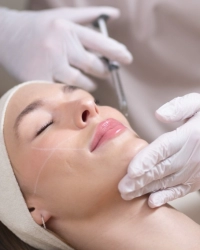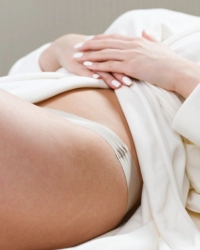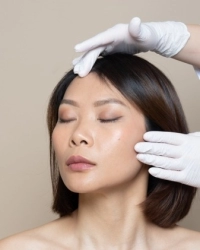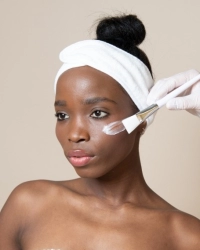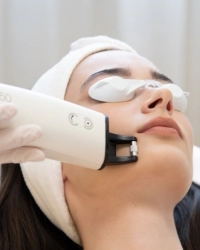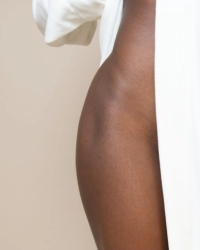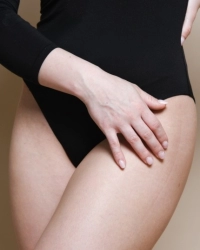Blepharoplasty
An immediate and eye catching solution to correct saggy eyelids and eliminate bags under the eyes.
Next

Blepharoplasty for a more youthful appearance
The eye area is one of the most challenging areas for many of us from an aesthetic point of view. Typically the first place to see the early signs of aging, caused by poor lifestyle choices, lack of sleep and other factors. As we age, the delicate skin around the eyes loses its elasticity. Smaller, superficial lines appear at first, then deeper wrinkles develop. The skin of the upper eyelids becomes thinner and saggier with age, even overhanging the eyelashes, which in severe cases can cause a reduced range of vision. Sagging of the lower eyelid can lead to hollowness and under-eye bags, giving the face a tired appearance. The problem can be amplified by poor lifestyle and hereditary predisposition. However, today we no longer have to live with this; blepharoplasty offers an ideal solution that is quick, effective and with only minimal discomfort.
Eyelid surgery can be performed to correct aesthetic problems of both the upper and lower eyelids. Upper blepharoplasty removes excess skin and reopens the area around the eyes, tightening the skin and restoring a fresh, youthful look. For the lower eyelid, if excess skin and puffiness have appeared along with under-eye bags, the removal of the excess fat that has built up and caused sagging can also be effectively treated to remove this disturbing aesthetic problem.


Quick and painless procedure with immediate results and without visible scars
- The results of blepharoplasty are visible immediately after the operation, thanks to the removal of excess skin and fat under the eyes. After the healing time the final result will be visible 6 weeks after the operation.
- The blepharoplasty is performed under local anesthesia or, on special request, under general anesthesia, making the procedure completely painless.
- Our experienced plastic surgeon positions the surgical scars in the upper eyelid where the crease is and in the lower eyelid in the lash line, making them virtually undetectable.
A personalized approach
The procedure is carefully planned beforehand to guarantee a natural result according to the different conditions, needs and eye shape. If desired, a special technique can also be used to create the more curved "cat-eye" effect that is so popular today.

Procedure
During the consultation, our plastic surgeon will assess the condition of the eye area and provide a detailed overview of the procedure and what results can be expected.
After the consultation, a surgical plan will be prepared, followed by the necessary tests that must be performed before the blepharoplasty. In most cases, a laboratory test is enough, but in case of certain diseases, medications, or if the patient has undergone plastic surgery before, other tests may be required.
Eyelid surgery is performed in our clinics basically in an outpatient setting under local anesthesia. However, it can also be performed under general anesthesia on special request.
The plastic surgeon will make an incision in the upper eyelid at the crease line and in the lower eyelid 1-2 mm below the eyelashes to release the sagging skin. This is important because the scar will be barely noticeable during the healing process. The excess skin over the inner corners is also removed during the operation.
In case of under-eye bags, excess sagging fat pads are removed and, if necessary, the extra fat can be used to fill in the small wrinkles and repair the depth of the inner corners, resulting in an even better result.
Lastly, the wound is closed with a so-called " over-and-over " suture under the skin surface, which is removed after 5 to 7 days at the follow-up examination.
Prices
| Plastic surgery consultation with examination - Dr. Máté Jancsó | 30 000 Ft |
| Plastic surgery consultation with examination - Dr. Máté Kiss | 30 000 Ft |
Appointment
Service
Selecting a location

Selecting a specialist

We recommend it for those who:
- the upper eyelid is sagging and become loose
- under-eye bags have appeared under the eyes
- wrinkles around the eyes are getting deeper
- excess skin and deep hollows have developed in the under-eye area, giving the face a tired appearance
Blepharoplasty takes approximately 1-1.5 hours depending on whether you have a lower or an upper blepharoplasty, or a combined one.
Regular medication can be taken before the procedure, but it is essential to consult your plastic surgeon if you are taking anticoagulant medication (e.g. aspirin). Post-operative recovery can be improved by drinking enough water, resting, reducing eye strain and using skin regenerating products recommended by the surgeon.
Because the tissues around the eyes are very sensitive , this area can swell, oedema and bruising can develop after the operation. Small amounts of bleeding is also normal. There may also be temporary difficulty in opening and closing the eye.
It is advisable to use ice packs/cold gel packs on the affected area for 1-2 days after surgery to reduce symptoms. During the healing period, you should pay special attention to the protection of the area around the eye from sunlight, and it is recommended to wear sunglasses during this period, regardless of the season. In addition, the use of make-up and other cosmetic products should be avoided for 8 days after the operation, and make-up use on the eyelashes, eyelids and eyebrows are not allowed for 3 weeks.
The recovery time is approximately 6 weeks, however 90% of the results are visible already after 3 weeks. The bluish-green discolouration and swelling following the procedure will completely disappear in approximately 1-3 weeks. The first medical check-up is after 1 week, at the time of the suture removal, when the plastic surgeon will monitor the healing process. This will be followed by a 6 week follow-up. Surgical scars are typically almost invisible after 2-3 months post-surgery. Slower healing or inadequate scarring is very rare.
All plastic surgery operations can have some risks, but these are negligible. Minor bruising, oedema and tightness may occur after surgery. In some cases, conjunctivitis may be experienced, which responds well to eye drops and chamomile compresses. Tearing or dry eyes may occur. As with all incisional procedures, patients who are prone to it may also develop scarring, keloid, hypertrophic or atrophic scarring, and inflammation of the surgical scar. In case of a known scarring disorder, the doctor should be informed during the consultation, as this may affect the course of the procedure and the aftercare.


